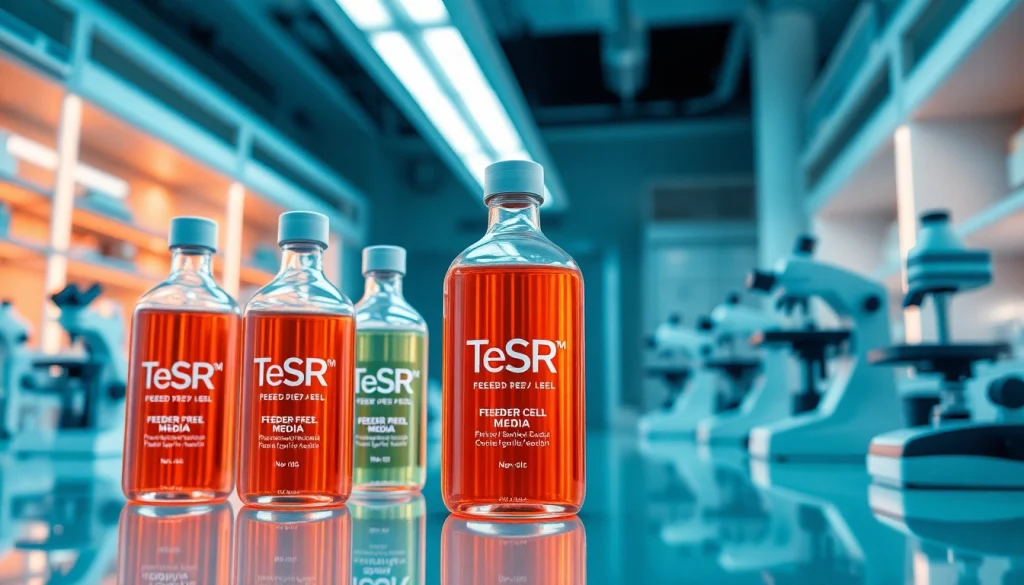Introduction to TeSR™ Feeder-Free Media
What is TeSR™ and Its Importance in Stem Cell Research?
TeSR™ refers to a series of feeder-free pluripotent stem cell culture media developed to support the growth, maintenance, and differentiation of human embryonic stem (ES) and induced pluripotent stem (iPS) cells. The development of TeSR™ media has significantly transformed stem cell research by providing a defined and controlled environment that enhances cell growth while maintaining pluripotency. This is crucial for researchers and practitioners aiming to utilize stem cells for therapeutic applications, regenerative medicine, and development biology.
By using TeSR™ media, researchers can experience increased reproducibility and reliability in their experiments. The unique formulations have been designed to exclude animal-derived materials, minimizing variability and reducing ethical considerations associated with using animal products in cell culture. Notably, the TeSR™ media family supports a variety of experimental setups, making it a versatile choice in laboratories worldwide. To explore the full range of options available, researchers can refer to all check.
Overview of the TeSR™ Product Line
The TeSR™ product line includes several variations tailored to different aspects of stem cell research. Some of the primary products are:
- eTeSR™: A dynamic adaptation designed for the maintenance of human pluripotent stem cells.
- mTeSR™ Plus: An enhanced media option that enables longer periods between media changes without compromising cell viability.
- TeSR™-AOF: This animal origin-free medium further reduces concerns surrounding contamination and regulatory compliance.
- TeSR™-E8™: A simplified formulation with minimal components that maintains essential cellular functions.
- ReproTeSR™: Specifically formulated for reprogramming differentiated cells back to pluripotent states.
- mFreSR™: Designed for the cryopreservation of stem cells, promoting their viability upon thawing.
Each product has specific applications tailored to facilitate particular phases of stem cell research, from initial culture conditions through to differentiation and cryopreservation.
Understanding Feeder-Free Culture Systems
Feeder-free culture systems have emerged as essential conditions that foster the growth of pluripotent stem cells while allowing researchers to maintain strict control over the experimental environment. Traditional culture systems often used feeder layers of fibroblasts to support cell growth, which could introduce variability and complicate experiments.
TeSR™ media eliminates the need for feeder layers by providing a defined matrix that delivers all necessary growth factors and nutrients directly to the cells. This approach not only enhances cell growth and extends their lifespan but also simplifies the process of scaling up cell cultures for research or therapeutic purposes.
Key Features and Benefits of TeSR™ Media
Consistency and Reproducibility in hPSC Cultures
One of the standout features of TeSR™ media is its ability to offer batch-to-batch consistency. Each formulation undergoes rigorous quality control to ensure reproducibility across experiments, which is critical in stem cell research where slight variations can lead to significantly different outcomes.
Researchers can benefit from a standardized protocol that translates to more predictable results in their experiments. For instance, the media is formulated based on peer-reviewed research, ensuring that it reflects the latest scientific understanding while also allowing for consistency in cell behavior, morphology, and differentiation.
Engaging Cytokines: Their Role in Culture Media
Cytokines play a pivotal role in the maintenance and differentiation of stem cells. TeSR™ media is enriched with specific cytokines that are essential for supporting the pluripotency of hPSCs. The presence of these factors directly influences cell signaling pathways involved in maintaining stemness and promoting self-renewal.
The tailored concentrations of cytokines in TeSR™ media ensure that cells receive optimal cues to thrive and maintain their pluripotent state. This aspect is crucial when inducing differentiation, as the right balance of cytokines can dictate developmental pathways, enhancing outcomes in experimental studies.
Compliance with cGMP Standards for Research
Compliance with Current Good Manufacturing Practice (cGMP) standards sets TeSR™ media apart in the sphere of stem cell research. These rigorous standards govern the manufacturing processes to ensure that all materials used in the production of TeSR™ media meet the highest quality and safety standards.
Utilizing media that adheres to cGMP enhances laboratory capabilities by providing assurance of product quality, particularly for research that may transition into clinical applications. This level of compliance is integral for researchers who aim to move their findings from the lab to real-world applications, ensuring safety and regulatory compliance in eventual therapeutic situations.
Application of TeSR™ Media in Differentiation Studies
Expanding Human Pluripotent Stem Cells (hPSCs)
TeSR™ media is not only effective for maintaining hPSCs but also plays a significant role in their expansion. Using formulations tailored for expansion, researchers can grow hPSCs to sufficient quantities for extensive studies or therapeutic preparations.
For instance, mTeSR™ Plus has been specifically designed to support weekend-free protocols that allow scientists to efficiently manage time and resources without compromising cell quality. This makes it feasible for labs to run expand protocols over extended periods, which is particularly valuable when scaling to meet clinical demand.
Typical Differentiation Pathways and Media Choices
Different formulations of TeSR™ media are optimized for guiding hPSCs down specific differentiation pathways. For example:
- TeSR™-E6: Tailored for directing differentiation into definitive endoderm, which is crucial for generating liver and pancreatic cells.
- TeSR™-E5: Supports the differentiation towards mesodermal lineages, making it suitable for producing cardiac and vascular cells.
- ReproTeSR™: Specifically designed for the reprogramming process, allowing the reverse conversion of somatic cells into pluripotent states.
These targeted formulations enhance the ability of researchers to achieve desired cell types reliably, ensuring consistency across different experiments and applications.
Real-World Applications and Case Studies
The practical applications of TeSR™ media in stem cell differentiation can be seen in numerous studies. For instance, Dr. Joseph C. Wu discusses differentiating hPSCs into hematopoietic cells, highlighting the use of TeSR™-E5 for efficient lineage specification.
Similarly, insights from Dr. Andrew Elefanty show how the application of TeSR™ media can lead to significant advancements in generating definitive endoderm, marking progress in therapeutic approaches for diabetes treatment. Such case studies underline the media’s versatility and effectiveness in addressing complex biological questions and therapeutic goals.
Challenges and Solutions in Stem Cell Culture
Common Issues in Maintaining Cell Quality
Despite advancements, researchers face challenges in maintaining cell quality and viability in stem cell cultures. Issues such as media contamination, genetic drift during passaging, and unwanted differentiation stresses can adversely affect outcomes.
Utilizing TeSR™ media mitigates some of these risks through its defined formulation, which helps minimize contamination from animal-derived components and ensures a sterile environment. Additionally, following recommended passaging protocols explicitly designed for TeSR™ products can help maintain the integrity of stem cell lines.
How TeSR™ Addresses Differentiation Variability
Variability in differentiation outcomes is a significant concern in stem cell research. The precise composition of TeSR™ media addresses this variability by offering consistent support across various stages of stem cell differentiation.
For instance, the carefully balanced cytokine profiles and nutrient compositions in TeSR™ media are designed to produce reproducible differentiation results. Researchers using these media can expect more uniform cell characteristics and functionalities, vastly enhancing the reliability of their applications in research and future clinical uses.
Regulatory and Ethical Considerations
The use of stem cells in research brings with it a host of regulatory and ethical considerations. The development of products like TeSR™ media that comply with cGMP standards supports researchers in navigating these complexities. Using animal-free components contributes to ethical considerations, fostering trust in the scientific community and aiding in the approval processes for clinical applications.
Transparency in the production processes and the sourcing of media ingredients enriches the ethical landscape, allowing researchers to focus more on scientific advancement while being compliant with regulatory demands.
Conclusion and Future Directions in hPSC Research
The Future of TeSR™ Media in Clinical Applications
As the field of stem cell research continues to evolve, so too will the applications of TeSR™ media. With ongoing advancements in regenerative medicine and cellular therapies, the potential for TeSR™ products is immense. Researchers are beginning to explore not only laboratory applications but also patient-oriented uses, allowing for tailored therapeutic strategies for a variety of conditions.
Continuous Innovation in Stem Cell Culture Technologies
Innovation remains at the core of the development of TeSR™ products. Continuous improvements in formulation based on new scientific insights will likely lead to even more specialized media that cater to nuanced scientific needs. This ensures that researchers have access to the most effective tools available as stem cell technologies progress.
Engaging with the Scientific Community for Research Advances
Establishing a dialog with the scientific community is essential for driving research forward. Through the collaborations and feedback obtained from researchers utilizing TeSR™ products, continuous improvements in formulations and applications will emerge. Engaging in forums, webinars, and discussions hosted by experts in the field will ensure access to cutting-edge knowledge that informs best practices and generates new insights.








